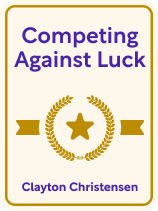

This article is an excerpt from the Shortform book guide to "Competing Against Luck" by Clayton Christensen. Shortform has the world's best summaries and analyses of books you should be reading.
Like this article? Sign up for a free trial here.
Want to learn about interviewing customers? How can customer interviews guide new product development?
If you want to know how to truly comprehend customer expectations, the answer lies in the art of interviewing customers. According to Clayton Christensen, by delving into their stories, you can uncover the motivating factors behind their purchases and gain invaluable insights for innovation.
Read on to learn how interviewing customers can guide product innovation, according to Christensen.
Create the Product That Consumers Want: Interviewing Customers
According to business academic Clayton Christensen, the first step of innovation is to identify the task you’re trying to resolve with your product. In Competing Against Luck, he offers suggestions for how to do this effectively, including interviewing customers. Here, we’ll explain his advice on how to conduct a customer interview to identify consumer expectations and create innovative products to meet them.
Tips for Conducting Customer Interviews
One of the most reliable ways to identify tasks (i.e. the specific purpose that customers accomplish by buying a product) is by interviewing customers, contends Christensen. Because tasks are so situation-dependent, you need a detailed picture of the customer’s life to fully understand the task that motivated them to make the purchase. A one-on-one conversation is the best way to uncover this level of detail.
(Shortform note: In The Mom Test, Rob Fitzpatrick warns that the fatal flaw of interviewing customers one-on-one is that they’ll instinctively tell you what they think you want to hear—typically, that they like your product and would buy it. As a result, most customer feedback actively pushes you toward failure by convincing you that bad product ideas are good. To avoid this, keep your conversation grounded in facts about the customer’s life that they can’t twist to make you feel better. For example, instead of asking a customer if they would buy and use your new smoothie blender, ask them about their recent eating habits to see if they would actually want an easier way to eat more fruits and vegetables.)
To identify a task associated with a purchase in sufficient detail to inspire innovation, you need all the context from the customer’s life that’s relevant to that purchase. For any purchase that a customer makes, there are encouraging factors influencing them to buy it and opposing, discouraging factors influencing them not to buy it. The encouraging factors include the problems causing them pain and the attractive benefits of the new product. The discouraging factors are the existing, habitual ways the customer solves their problems and their doubts and fears about the new product (that it’ll be a waste of money or make their life worse).
When interviewing customers, Christensen recommends asking customers to tell you the story of their life leading up to a specific purchase and identifying the encouraging and discouraging factors at play, as they’re all components of the task driving the purchase.
For example, a customer might describe the last time he bought a winter coat: He was planning to take a trip to Canada to go camping with some friends. He thought about buying a warm, puffy winter coat. However, he worried that his friends would make fun of him, so he decided to buy a thin coat instead and ended up suffering through the bitter cold. Stories like this illuminate the encouraging factors (I want to be warm) and discouraging factors (I don’t want my friends to make fun of me) customers consider when making a purchase.
With this story, you could set out to design a coat that solves the following task: “Keep me warm in the cold outdoors without drawing too much attention to how I look.”
| Applying Christensen’s Interview Techniques to Sales You can also use Christensen’s strategy for interviewing customers to enhance your ability to make direct sales. This is one of the main ideas behind Neil Rackham’s SPIN Selling, which is about increasing the encouraging factors in a customer’s mind until they’re greater than the discouraging factors while making a sale. Rackham recommends achieving this by asking the customer questions that get them to talk themselves into making the purchase. He recommends using four types of questions in a specific order to accomplish this, represented by the acronym “SPIN.” – S – Situation Questions: investigating the customer’s life to help you understand what questions you’ll need to ask next – P – Problem Questions: discovering the problems and frustrations in the customer’s life, which are the encouraging factors pushing them to make a purchase – I – Implication Questions: asking the customer to consider how the consequences of their problems are worse than they assume, intensifying one major encouraging factor – N – Need-Payoff Questions: asking the customer to consider how your product would improve their life by resolving their problems, intensifying the other major encouraging factor Here’s an example of a sales pitch using these four types of questions: Imagine you’re trying to sell a moped. First, ask “If you had to get to the other side of town right now, how would you get there?” (Situation). Then, ask “What is your biggest gripe with this city’s public transportation system?” (Problem). Continue by asking “How would you say the time you waste riding the bus makes your life worse?” (Implication). Finally, ask “What good could you do with the time you save by owning your own transportation?” (Need-Payoff). |

———End of Preview———
Like what you just read? Read the rest of the world's best book summary and analysis of Clayton Christensen's "Competing Against Luck" at Shortform.
Here's what you'll find in our full Competing Against Luck summary:
- How to analyze consumer demand to guide product innovation
- How you can design and sell a product that can't possibly fail
- Tips for increasing your company's chances of success






